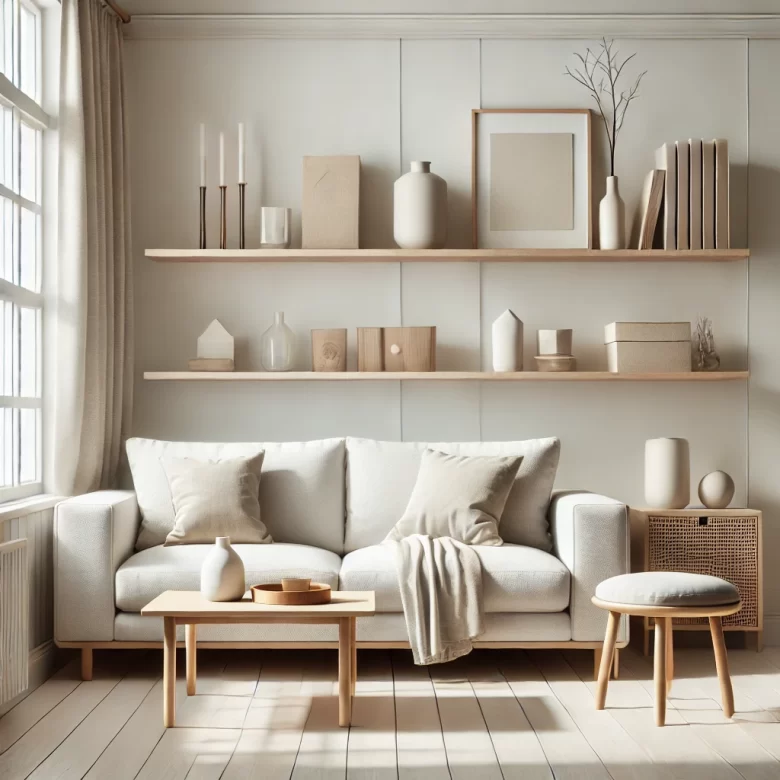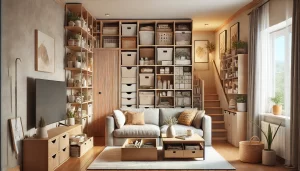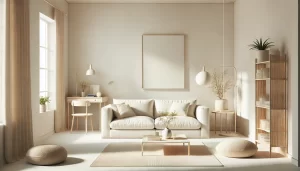Introduction
Have you ever walked into your home after a long day and immediately felt overwhelmed by the clutter and endless piles of items scattered around? Whether it’s the never-ending stack of papers on the kitchen counter or the overflowing closet that you can barely open, clutter has a way of making your home feel chaotic and stressful. It’s a feeling many of us know all too well.
Simplifying your home can be a game-changer. By reducing the clutter, you can create an environment that feels calm, organized, and, most importantly, stress-free. A simplified space allows you to focus on what truly matters and helps you feel more in control of your surroundings. When your home is organized, you’re not just saving time searching for things—you’re also saving mental energy.
In this article, we will explore practical tips for reducing excess items in your home. Whether it’s through decluttering your living room, kitchen, or even your closet, we’ll guide you through actionable steps to simplify your space. By the end of this guide, you’ll have the tools you need to transform your home into a more functional and peaceful place to live.
Simplifying your home isn’t just about getting rid of things; it’s about creating a space that supports your well-being. Reducing excess items not only minimizes stress but also enhances productivity, allowing you to live a more intentional and fulfilling life.
Understanding the Need for Simplification
The Psychological Impact of Clutter:
Clutter isn’t just a physical problem; it can also take a toll on your mental and emotional well-being. Studies have shown that excess items in your living space can lead to feelings of stress, anxiety, and even depression. When your surroundings are disorganized, it can create a sense of being overwhelmed, making it harder to relax or focus. This constant mental burden can drain your energy and leave you feeling mentally fatigued, even if you’re not consciously aware of it.
Benefits of a Simplified Space:
On the other hand, simplifying your home offers a range of benefits that go beyond just the physical environment. A simplified space promotes improved focus by reducing distractions and creating a clean, calming atmosphere. With fewer items to manage and organize, you’ll find it easier to stay on top of tasks, improving your time management. Most importantly, a clutter-free home fosters a sense of calm, providing you with a peaceful sanctuary where you can recharge and feel more centered.
Why People Hold Onto Stuff:
Despite the negative effects of clutter, many of us find it difficult to part with items. The reasons behind this attachment vary, but one of the biggest factors is sentimental value. People often hold onto items that remind them of special moments or loved ones, even if they no longer serve a practical purpose. Another common reason is the fear of waste or regret—”What if I need this someday?” This mindset can lead to the accumulation of unnecessary things. Additionally, the “just in case” mentality often causes us to keep items that we might never actually use, but we’re unsure about discarding them. Understanding these emotional triggers is an important step toward letting go of excess items and creating a space that truly serves you.
Decluttering Strategies for Each Room
Living Room:
Prioritize Functional Furniture: When selecting furniture for your living room, look for pieces that offer both comfort and storage. Sofas with built-in drawers, coffee tables with hidden compartments, and shelves that double as storage units can help keep your space organized while serving a practical purpose. This way, you’re not just adding furniture—you’re creating smart solutions that reduce clutter.
Declutter Surfaces: In the living room, surfaces like coffee tables, mantels, and side tables can quickly accumulate unnecessary items. To maintain a clean and serene environment, keep only essential decor items on these surfaces. A couple of carefully selected items, like a vase of flowers or a favorite book, can add character without overwhelming the space.
Organize Entertainment Areas: Technology and media equipment can easily cause clutter, especially in the entertainment area. Organize wires and gadgets using cable management solutions, and consider mounting your TV on the wall to free up space. Keep only the most frequently used devices and storage for DVDs or games, discarding any obsolete tech to reduce the visual clutter.
Kitchen:
Keep Countertops Clear: The kitchen is often the heart of the home, but it can easily become crowded with small appliances, utensils, and miscellaneous items. To maintain a clean and efficient workspace, store small appliances in cabinets or drawers when not in use. Only keep the essentials, such as a toaster or coffee maker, on the counter.
Assess Your Dishes and Utensils: Over time, we tend to accumulate dishes and utensils that we rarely use. Regularly assess your kitchenware and keep only the items that you actually use daily. Donate or discard duplicates, or anything that no longer serves a purpose in your cooking routine.
Pantry Organization: The pantry is another area where excess items can quickly pile up. Begin by discarding expired food and consolidating duplicate items. Organizing pantry shelves by category—grains, canned goods, spices—will not only make it easier to find what you need but will also help prevent purchasing unnecessary duplicates.
Bedroom:
Capsule Wardrobe Concept: The bedroom is often home to overflowing closets, but adopting a capsule wardrobe can make a huge difference. Limit your clothing to essential, versatile pieces that can be mixed and matched, reducing the overall volume of your wardrobe. This approach promotes mindful shopping and ensures your closet remains organized and functional.
Bedside Minimalism: Your bedside table should be a place of calm, not clutter. Avoid piling up books, gadgets, and miscellaneous items. Keep only the essentials—like a lamp, clock, or a journal—and consider storage options like drawers or trays to keep things organized and easily accessible.
Closet Clean-Out Routine: Set a regular schedule to declutter your closet—whether it’s twice a year or every season. During this process, go through your clothes, shoes, and accessories, and donate or discard anything that no longer fits, is worn out, or doesn’t suit your current style. By making it a routine, you’ll maintain a closet that’s manageable and clutter-free.
Bathroom:
Limit Toiletries: Bathrooms are notorious for accumulating toiletries, from half-used bottles to expired products. Regularly assess your products and dispose of anything past its expiration date. Minimize duplicates, and opt for multi-use items where possible to reduce clutter.
Towel and Linen Control: Having too many towels or linens can overwhelm the bathroom space. Keep only the necessary sets—one for daily use, one spare, and perhaps a few decorative ones. Store extras in a linen closet or drawer to prevent them from piling up and taking up valuable space.
Streamline Personal Care Items: Similar to toiletries, personal care products can take over your bathroom. Store away non-daily items, such as special treatments or perfumes, in cabinets or drawers. Keep daily-use products, like toothpaste, deodorant, and soap, organized and within easy reach to keep your bathroom feeling tidy and functional.
Practical Tips to Reduce Excess Items
Adopt the One-In, One-Out Rule:
One of the simplest and most effective ways to maintain a clutter-free home is by adopting the One-In, One-Out Rule. This principle means that for every new item you bring into your home, you must remove one existing item. Whether it’s a new piece of clothing, a gadget, or even a piece of decor, something else has to go. This habit helps prevent accumulation and encourages you to think carefully before making new purchases. It’s a continuous process that fosters a minimalist mindset and ensures that your home remains balanced and organized.
Use the “Four-Box Method” for Decluttering:
Decluttering can feel overwhelming, especially when you don’t know where to start. The Four-Box Method provides a structured approach that makes the process more manageable. Begin by selecting one area or room to tackle and place four boxes labeled: Keep, Donate, Sell, and Trash.
Keep: Items that you use regularly or have significant value.
Donate: Items that are in good condition but no longer needed.
Sell: Valuable items you can monetize, such as electronics or collectibles.
Trash: Broken or unusable items that need to be disposed of.
By systematically going through your belongings and categorizing them, you’ll make thoughtful decisions and create a more organized space. This method also reduces guilt, as you’re actively deciding to give useful items a new purpose, rather than just discarding them.
Be Mindful of Future Purchases:
A major aspect of maintaining a simplified home is changing your mindset from impulsive buying to intentional purchasing. Instead of asking, “Do I want this?” shift your thinking to “Do I need this?” Consider whether the item adds real value to your life or if it will just become another piece of clutter.
Pause Before Buying: Give yourself time to think before making purchases, especially for non-essential items.
Quality Over Quantity: Invest in durable, multipurpose items rather than accumulating numerous cheap alternatives.
Avoid Sales Temptation: Just because something is discounted doesn’t mean you need it. Only purchase sale items that fulfill a genuine need.
Being mindful of your consumption habits not only helps reduce clutter but also saves money and promotes more thoughtful living.
Set Realistic Goals:
Decluttering your entire home at once can be daunting and often leads to burnout. Instead, set realistic and achievable goals to break down the process into manageable steps.
Focus on One Space at a Time: Whether it’s a drawer, a shelf, or an entire room, tackling one area allows you to see progress without feeling overwhelmed.
Set Time Limits: Dedicate 20-30 minutes each day to decluttering rather than trying to do everything at once.
Track Your Progress: Take before and after photos to motivate yourself and see the difference.
By creating a realistic plan and sticking to it, you’ll gradually transform your space without the stress of taking on too much at once. Remember, the goal is progress, not perfection.
Maintaining a Simplified Home
Develop Daily Habits:
Maintaining a clutter-free home doesn’t have to be a daunting task if you develop simple daily habits. One of the best ways to prevent clutter from building up is to put things back in their designated places as soon as you’re done using them. Whether it’s your keys, clothes, or dishes, consistently returning items to their rightful spots helps keep your home organized and ensures that nothing piles up unnecessarily. This habit, though small, can have a huge impact on maintaining a clean and functional space. By staying on top of things daily, you’ll avoid the overwhelming task of dealing with clutter later on.
Seasonal Decluttering:
Even if you’ve decluttered your home thoroughly, items tend to accumulate over time. That’s why implementing seasonal decluttering routines is essential. At the change of each season, take the time to assess your belongings and get rid of anything that no longer serves a purpose. For example, you might want to swap out winter clothing for spring items and donate or discard those that no longer fit or are worn out. Similarly, check your kitchen, bathroom, and other areas for expired products or items that are no longer needed. By making seasonal decluttering a habit, you’ll ensure that your space remains functional and free of excess year-round.
Stay Inspired:
The journey toward a simplified home is ongoing, and it can sometimes be challenging to stay motivated. One way to keep the momentum going is to follow minimalism communities and resources for ongoing inspiration. Whether it’s through blogs, social media accounts, books, or podcasts, there’s a wealth of content available to help you stay inspired and focused on your decluttering goals. These communities often share success stories, tips, and new ideas that can reignite your passion for maintaining a simplified space. Surrounding yourself with like-minded individuals who value simplicity can also create a sense of accountability and encouragement.
Embrace Digital Minimalism:
Decluttering isn’t just about your physical space; it’s also essential to reduce digital clutter. Digital minimalism involves streamlining your online life, from organizing your files to cleaning up your email inbox and social media accounts. Start by deleting old files, unsubscribing from irrelevant email lists, and unfollowing accounts that don’t align with your values. Consider organizing your digital photos and documents into clear folders so you can easily find what you need. Reducing digital clutter not only creates a more organized virtual environment but also helps to declutter your mind, leading to increased focus and productivity. Embracing digital minimalism is a crucial step in maintaining an overall simplified and balanced lifestyle.
Conclusion
Simplifying your home is not just about getting rid of excess items; it’s about creating a space that supports your well-being and enhances your quality of life. Throughout this article, we’ve explored practical tips to reduce clutter, including prioritizing functional furniture, maintaining organized spaces in each room, and using strategies like the One-In, One-Out Rule and the Four-Box Method. We also highlighted the importance of developing daily habits, implementing seasonal decluttering routines, staying inspired through minimalism communities, and embracing digital minimalism. By incorporating these strategies into your daily life, you can transform your home into a peaceful, organized sanctuary that promotes both physical and mental well-being.




